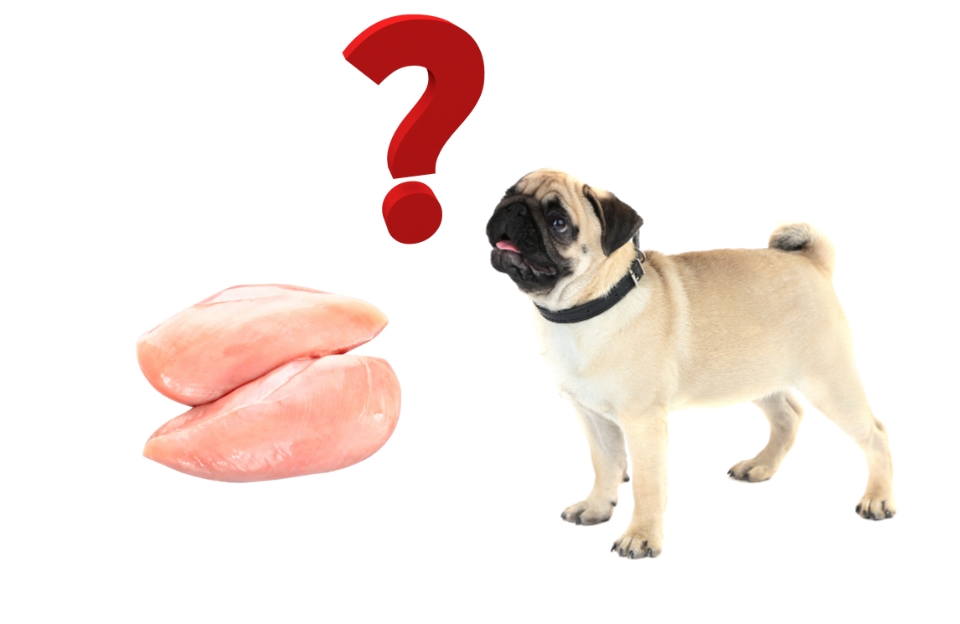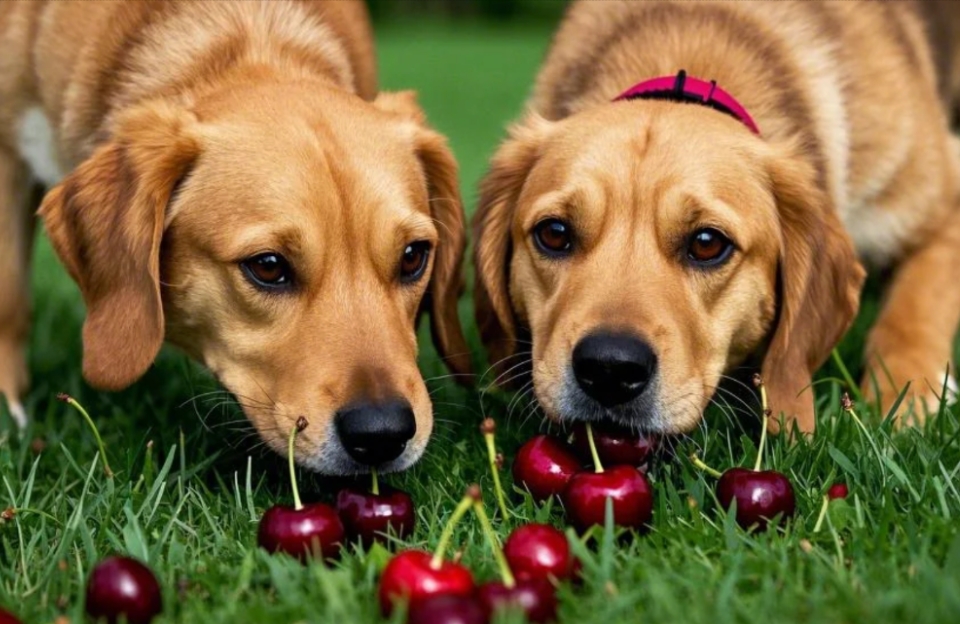Last Updated on February 19, 2025 by Falcone Dulce
The question, ‘Can Dogs Eat Raw Chicken?’ seems to be particularly controversial for dog owners. Dog owners have changed their dietary habits due to a “Raw Food Movement” where they examine the pros and cons of feeding raw food and making chicken a part of the diet. Supporters of raw diets argue that not only do dogs perform better, but their energy levels, health, and even coat condition improves when they are fed wholesome unprocessed food. Nevertheless, the balance between nutrition and food safety raises important issues regarding the existence of raw-fed dog systems. This controversy makes it essential to examine whether serving dogs raw chicken is a good lifestyle choice. This article will analyse various feeding aspects of raw chicken to dogs, including benefits, concerns, and reservations that come with the nutritional practice and, thus, prepare the reader for the endeavour. For those interested in exploring more about natural dietary options, you might also wonder about the potential benefits of including eggshells in your dog’s diet.
The Controversy Surrounding Raw Chicken for Dogs
Feeding raw chicken to dogs has raised eyebrows and sparked arguments among dog owners, veterinarians, and even pet nutritionists. A major discussion has centred around the pros and cons of raw food diets.
| Arguments | For | Against |
| Natural Diet Mimicry | Feeding raw chicken mimics the diet of wild canines, leading to potential health benefits. | |
| Improved Coat Condition | Many dog parents report shinier, healthier coats due to natural oils and nutrients in raw meats. | |
| Enhanced Dental Health | Chewing on raw bones promotes better dental hygiene, reducing plaque buildup and preventing periodontal disease. | |
| Increased Energy Levels | Dogs on a raw diet often exhibit higher energy levels and vitality, likely due to the absence of fillers in commercial dog food. | |
| Bacterial Contamination | Raw chicken can harbor harmful bacteria like Salmonella and Campylobacter, posing risks to both dogs and humans. | |
| Nutritional Imbalances | A raw diet must be carefully planned to avoid deficiencies in essential nutrients, particularly for puppies and senior dogs. |
We have previously outlined arguments for and against dogs consuming raw chicken; now let us shift the concern to other factors to provide you with the rationale that surrounds this particular issue.
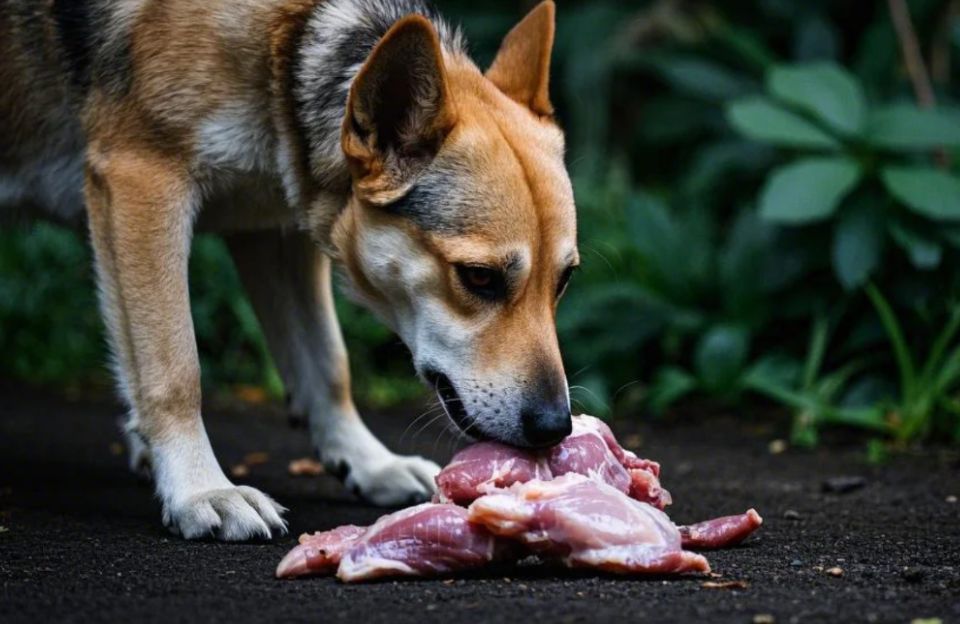
Advantages of a Raw Diet for Dogs
As a result of purported nutritional value and positive impacts on general health, dog owners have increasingly adopted raw diets for dogs in recent years.
Nutritional Benefits of Raw Food
Overall, these raw food diets consist of a balanced diet made up of unprocessed meats, bones, and organs that are of good quality and contain a higher level of nutrients than other dog food brands. Furthermore, this method tends to have high protein content, which is important for growing muscles, energy, and functions in your dog. In addition, raw diets provide healthy fats which assist in energy provision, body temperature regulation, healthy skin, and a shiny coat. These proposed diets enable the dog to obtain a variety of vitamins such as B, iron, and zinc needed for their general wellbeing.
Improved Digestion and Absorption of Nutrients
Numerous dog parents find that their dogs have better digestion after switching to a raw diet. Raw foods also come with natural enzymes that assist in the digestive process that helps the dogs to digest and absorb nutrients better. Raw diets franchise less carbs than business kibble, which ought to bebeneficial for dogs that are sensitive and grain or filler. Eating fewer carbs often means less gastrointestinal upset — and more bowel regularity.
Benefits for Skin and Coat Health
One of the most obvious benefits of raw food is the effect on a dog skin and coat. The oils and healthy fats in raw meats and fish can also help puppies and dogs have shinier coats which is frequently a result of better hydration and nutrient absorption. It can also reduce skin irritations and allergies, since raw diet eliminates preservatives and other artificial additives used in many commercial dog food, all of which can contribute to allergic reactions. A raw diet can be attractive due to potential benefits such as improved nutrition, digestion, and skin/coat.
Risks of Feeding Raw Chicken
While feeding your dog raw chicken may be advantageous, there are inherent dangers to be mindful of.
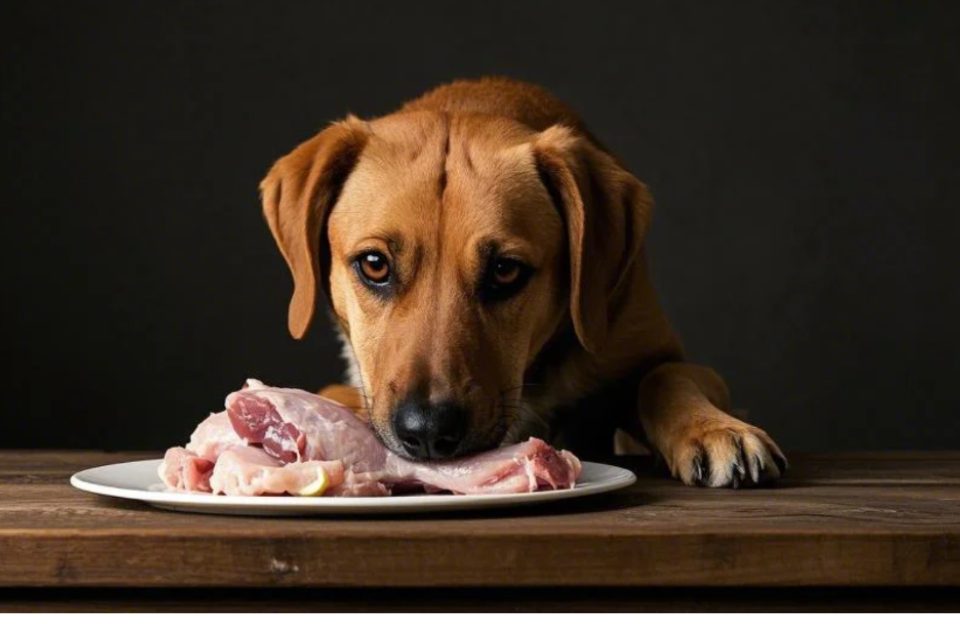
Potential Risks
Bacterial Contamination
Raw chicken may carry disease-causing bacteria, including Salmonella and Campylobacter, that can lead to serious gastrointestinal disease in dogs and humans. Such bacteria can cause vomiting, diarrhea, fever and abdominal pain. Working with raw chicken also poses a risk of cross-contamination, in which bacteria transfer to surfaces, utensils, and other foods—especially if proper hygiene practices are insufficient.
Choking Hazards
Some parts of raw chicken, specifically the bones, can splinter as they’re chewed, making them a possible choking hazard or threatening serious injuries to a dog’s mouth, throat or digestive tract. Additionally, large pieces of raw chicken can pose a choking hazard.
Adverse Reactions
Some dogs are allergic to chicken, or they may have sensitivity issues that can cause gastro-intestinal and skin problems, so any dietary changes should be monitored very closely. Also, a sudden switch to a raw diet can cause digestive upset, which can lead to diarrhea or vomiting, especially if the transition is abrupt.
First Reactions: Dogs Eating Raw Chicken
Adding raw chicken into a dog’s diet can produce varied responses depending on their prior experiences and instincts. Knowing these initial responses helps dog caregivers manage the changes associated with a raw diet more seamlessly.
Typical Reactions
When offered raw chicken for the first time, dogs’ reactions can differ significantly from one puppy to the next. As in the case of many pets, dogs tend to display their instinctive behaviours such as biting and consuming the food offered to them and will often wag their tails, bark, or jump around when they smell or see raw chicken. Nevertheless, a few dogs may adopt a more reserved stance initially, walking away or cautiously smelling, especially if they have only been fed kibble. Once this baseline is established, which does not usually take long, dogs tend to dive into the raw chicken eating with great gusto and bite into it without restraint.
Factors Influencing Their Reactions
The way that a dog reacts to raw chicken can be influenced by several factors. Different dogs tend to bring different characteristics to a meal that needs to be raw – those who have been fed a high-quality meat diet would need little to no time to transition, while those fed on kibble or processed foods would need more time. Their natural behaviour and instincts can also be relevant, as there is an innate tendency for dogs to be able to eat meat which triggers intrinsic feeding behaviour that is linked to their evolutionary past as hunters. Both positive and negative past experiences with raw foods also have an impact on their reactions; dogs with positive raw food associations would likely embrace it, while some with negative experiences, like an upset stomach from certain foods, might be more guarded or hesitant. On top of that, every single dog possesses an individuality that defines their reaction – whether they are adventurous, reserved, or timid, one’s character has a huge bearing on how they deal with set dietary changes.
Safety Precautions
Dogs can benefit from raw chicken, but there are notable safety concerns at the same time. Raw chicken must be fed to dogs with special attention to avoid negative implications on their health and wellbeing as well as that of the owner.
Key Points to Ensure Safe
Owners can mitigate risk and adopt practices that enhance the safety and well-being of the dog by following certain procedures. It is critical to source chicken from reputable suppliers and prefer organic or free-range chicken as it is less likely to have harmful antibiotics and other additives. When dealing with frozen raw chicken, make sure to thaw it in the refrigerator as thawing at room temperature will encourage the growth of harmful bacteria. Controlling portions also matters; the meat must be split based on the dog’s age, size, and nutritional requirements to avoid digestive issues from underfeeding and overfeeding. Raw chicken should be handled with care to avoid cross-contaminating surfaces set for other meat; all surfaces and tools must be cleaned after raw chicken is used. Finally, raw chicken can be introduced to the dog’s diet slowly while monitoring them for vomiting, diarrhoea, and other gastrointestinal symptoms that may arise. Seek the advice of a veterinarian when these symptoms appear.
Importance of Hygiene and Proper Storage
Adequate hygiene must be maintained while feeding dogs any raw chicken, be it in terms of bacteria or general cleanliness. The first step is ensuring the surfaces hands come in contact with while washing pre or post handling the raw chicken are as clean as they can be; this helps prevent as much as possible the bacteria from getting transferred to other surfaces or foods. If any raw chicken is left over, use it within a day or two to ensure freshness, and to prevent it from going bad, place it in the freezer. The freezer will keep the chicken fresh for multiple months, label the containers with the date to ensure that you do not lose track of the date. After cooking for the chickens, it is essential that you have a separate clean-up plan set in place; this must include cleaning the feeding area to ensure the leftovers and chicken pieces do not go bad. Bacteria thrive in rotting food, so make sure none is left over. Also make sure everyone in the house, including young children, understands the basic rules of hygiene when it comes to raw chicken and dog feeding. If set, these plans could provide a way for the dogs to have better hygiene.
Suitable Parts of Raw Chicken
Now let’s find out suitable parts of raw chicken for your dog’s diet. In this article, we divide the raw chicken into 5 parts and each part serves different nutritional value. Let’s check them out!
| Chicken Part | Benefits | Nutritional Value |
Chicken Breasts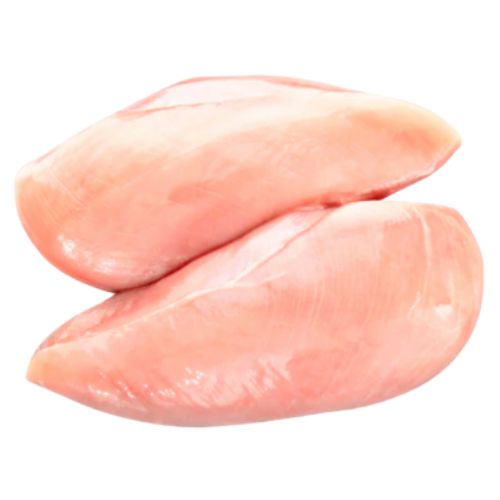 | Lean cuts rich in protein, ideal for active dogs; low in fat for weight maintenance. | Packed with essential amino acids for muscle development; contains vitamins like B6 for metabolism and immune function. |
Chicken Thighs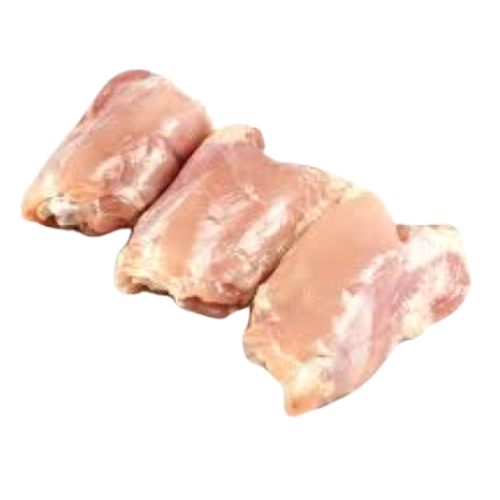 | Higher in fat, providing a calorie-dense option; great for energy needs in active breeds. | Good balance of protein and fat; rich in minerals like iron and zinc for healthy blood and immune function. |
Chicken Wings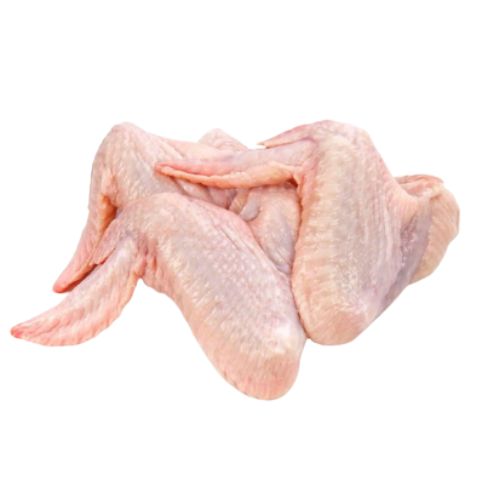 | Tasty and satisfying to chew, helping maintain dental health; contains meat and skin. | Rich in glucosamine and chondroitin for joint health, beneficial for older dogs or those with joint concerns. |
Chicken Necks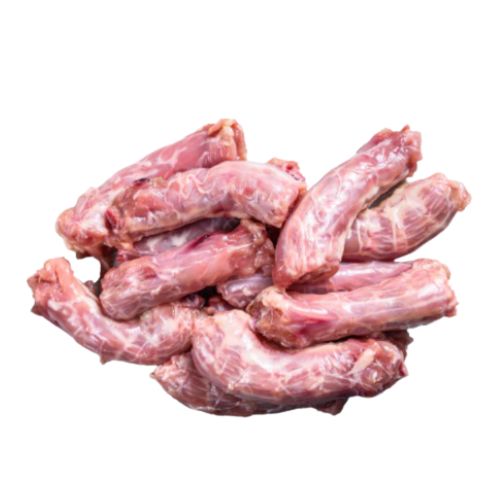 | Provides nutrition and dental benefits; chewy texture helps reduce tartar buildup. | Rich in calcium and phosphorus, supporting bone health and overall growth and development. |
Chicken Liver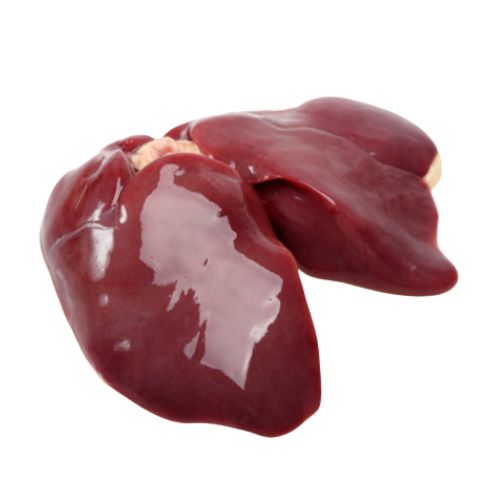 | Highly nutritious; should be fed in moderation due to rich nutrient content. | Excellent source of vitamins A, B vitamins, and essential fatty acids, promoting good vision and immune health. |
Reliable Sources for Raw Chicken
In sourcing fresh raw chicken, there are many options available and it mainly depends on the quality of the chicken you need. The place from which you choose to buy raw chicken dictates the quality of meat as well as how safe and clean it is. Local farms, specialty shops, farmers’ markets, and even some online retailers uphold chicken freshness and use humane practices, enabling them to provide high-quality chicken. Health risks can be minimised by adopting safe procedures when handling raw chicken, including taking the right steps to maintain freshness:
Common Recipes to Pair with Raw Chicken
It is advisable to combine raw chicken with other foods when feeding them to dogs to ensure they have a well-balanced diet. Here are some simple ingredients, vegetables, and supplements that can be combined with raw chicken to enhance your dog’s diet.
| Category | Ingredient | Benefits | Preparation |
| Vegetables | Carrots | Rich in beta-carotene and fiber | Finely chopped or grated |
| Spinach | Packed with vitamins A, C, and K | Added raw or lightly steamed | |
| Pumpkin | Great for digestion | Canned or cooked, mixed into meals | |
| Sweet Potatoes | Provides fiber and essential nutrients | Cooked and mashed | |
| Fruits | Blueberries | High in antioxidants | Added whole or mashed |
| Apples | Offers vitamins; remove seeds and core, then chop | Chopped into small pieces | |
| Supplements | Fish Oil | Provides omega-3 fatty acids for skin and coat health | A few drops mixed in |
| Probiotics | Aids digestion | Sprinkled over meals as directed by your vet | |
| Bone Meal | A calcium supplement for additional minerals | Added to meals |
Simple Recipes
Here are some simple recipes for dog owners if they want to add raw chicken into their dog’s diet.
Chicken and Vegetable Mix:
- Ingredients: 1 cup raw chicken (diced), 1/2 cup carrots (grated), 1/2 cup spinach (chopped), and a tablespoon of fish oil.
- Instructions: Combine all ingredients in a bowl and mix well. Serve fresh, and store any leftovers in the refrigerator for up to 3 days.

Chicken and Pumpkin Mash:
- Ingredients: 1 cup raw chicken (shredded), 1/2 cup canned pumpkin, and 1/4 cup blueberries.
- Instructions: Mix shredded chicken with canned pumpkin and top with blueberries. This recipe is especially good for dogs with digestive issues.
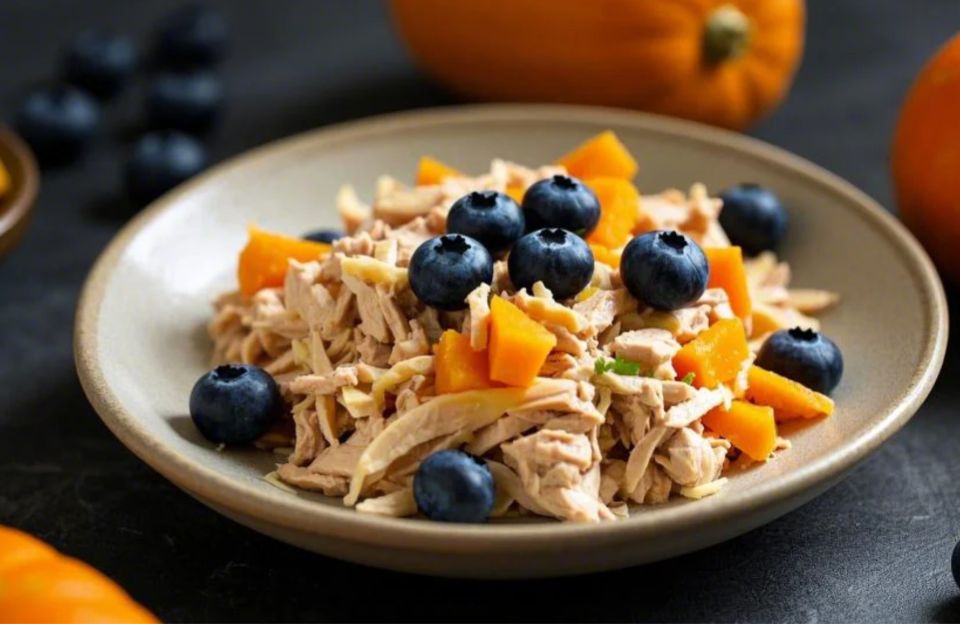
Chicken and Sweet Potato Bowl:
- Ingredients: 1 cup raw chicken (chopped), 1/2 cup cooked sweet potatoes (mashed), and a tablespoon of bone meal.
- Instructions: Combine the chopped chicken with the mashed sweet potatoes and bone meal. Mix thoroughly and serve.
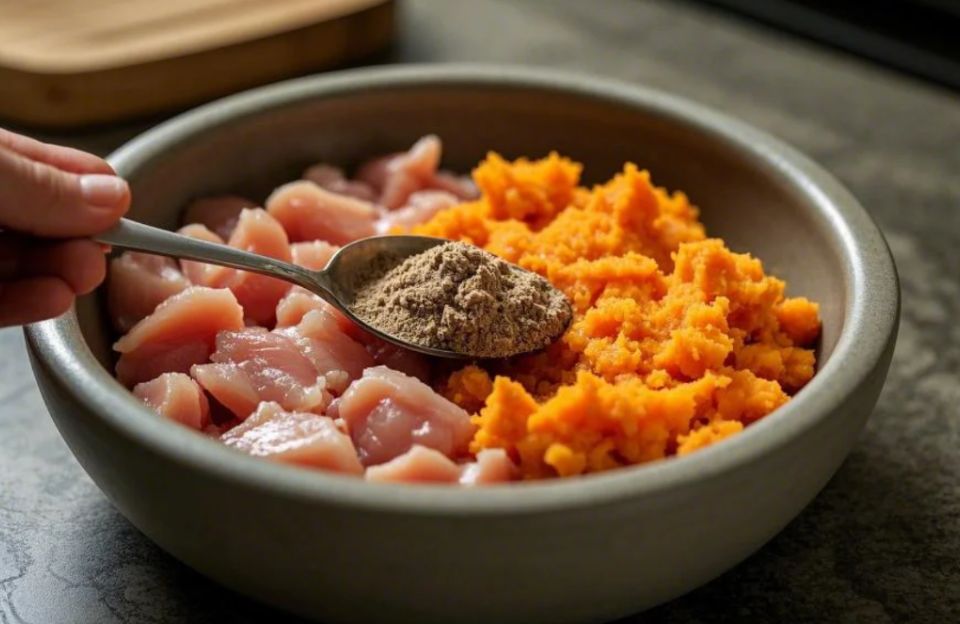
Chicken and Apple Treats:
- Ingredients: 1 cup raw chicken (ground), 1/2 cup apple (finely chopped, seeds removed), and 1/4 cup oats.
- Instructions: Mix all ingredients in a bowl, form small patties, and serve them raw or lightly cooked.
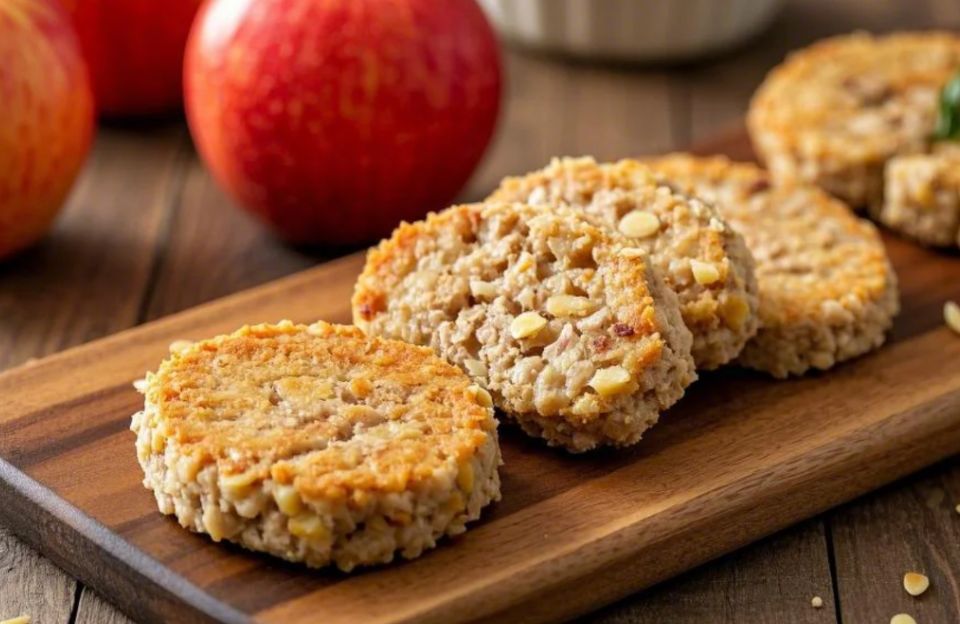
Final Thought
There’s an array of emotions for pet on feeding raw chicken to their dogs, excitement being one of them. Pondering over the mostly positive factors, the most solution-worthy one is better nutrition with other positive impacts such as a healthy coat and improved digestion. On the other side of the coin, it might bring about bacterial contamination and nutritional imbalances. A good, well-thought-out approach such as clean sourcing and meticulous handling can help mitigate risks such as these.
ach dog is unique; hence, their nutritional needs may vary with age, breed, and general health. Consulting a veterinarian or a pet nutritionist can provide invaluable information tailored to the needs of your dog. Whether you decide to add raw chicken to your dog’s diet or not, ensuring your pet has a balanced diet remains a primary goal.

